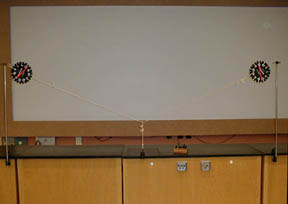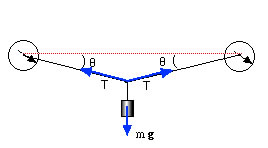Demos: 1J-03 Force Components

 Two spring balances are mounted approximately 4 m apart and are connected by a string having a small amount of slack. A weight hangar is suspended at the center of the string. The scales show a small (equal) reading. If a small (e.g. 2 kg) weight is attached, the scales show a much larger reading than the weight itself. From the diagram we see that:
Two spring balances are mounted approximately 4 m apart and are connected by a string having a small amount of slack. A weight hangar is suspended at the center of the string. The scales show a small (equal) reading. If a small (e.g. 2 kg) weight is attached, the scales show a much larger reading than the weight itself. From the diagram we see that:

As q approaches zero, T becomes indefinitely large.
Directions: Be sure that the weight hanger is centered so that the scales read equally. Loops are placed along the string in such a way that the angle can be made smaller. Focus attention on the scales as you make the angle smaller and smaller.
Suggestions for Presentation: Ask how a small weight might be able to produce a very large force. At first, make the angle reasonably large, then proceed to make it smaller and smaller. At some point, the tension will equal the weight (q = 30°). If you continue to make the angle smaller, you can reach a point where the readings go off the scale. Question: Can the string holding the weight ever be perfectly horizontal?
Companion demo: Have two students hold a sturdy rope between them and pull it as tight as possible. Have another student push down at the center with a small force (using, say, the index finger). An alternative is to hang a 5-kg weight from the rope and challenge the students to make the rope horizontal. It isn’t possible. (With a 5-kg weight, the sag is easily visible, no matter how hard they pull.)
Applications: Lots of applications. Attach a chain to a car with the other end anchored to a immovable object. Pull sideways on the center of the chain. A small pull can produce large forces in the chain, enabling it to be pulled out of mud, for example. A tight wire walker in the circus will produce enormous tensions in the wire if it is maintained with little sag.
Last Updated: Nov 30, 2023 11:25 AM